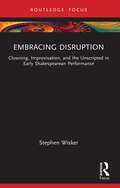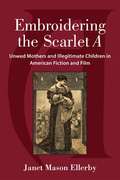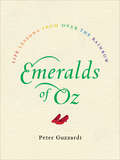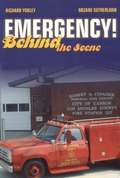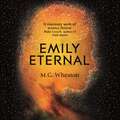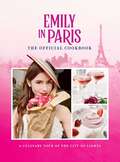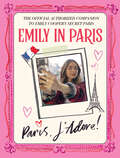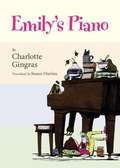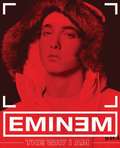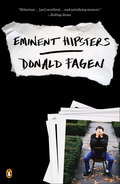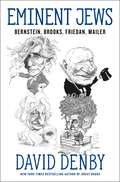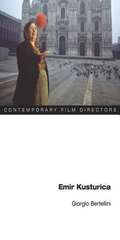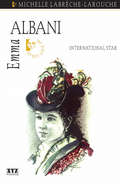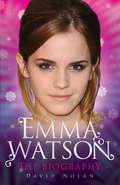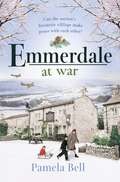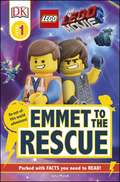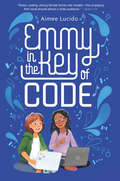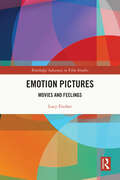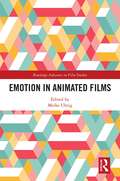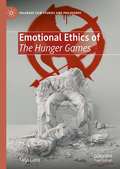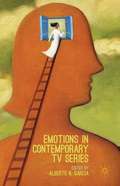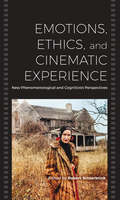- Table View
- List View
Embracing Disruption: Clowning, Improvisation, and the Unscripted in Early Shakespearean Performance (Routledge Advances in Theatre & Performance Studies)
by Stephen WiskerThis volume celebrates the centrality of clowning in Shakespeare’s conception of theatre and explores how he purposefully invited the clown’s anarchic energy into the heart of his dramaturgy.Clowning was a potent but divisive force in the theater of Shakespeare’s time, challenging the emerging tyranny of decorum and the developing notion of the authorial voice. As such, the figure of the clown is key to understanding the pervasive tension between existing and emergent forms of Elizabethan theater, and unlocks forgotten levels of meaning in Shakespeare’s plays, meanings that were only fully experienced in performance rather than on the page. The great clown Dick Tarleton dominated the London theater of the 1580’s and deeply informed Shakespeare’s understanding of the anarchic power of performance. By the 1590’s, however, the clown’s voice was increasingly silenced by emerging theater practice intent on authorial control and Elizabethan codes of decorum. Against the dominant critical tide, Shakespeare continued to embrace clowning and worked closely with Will Kemp—Tarleton’s successor as the greatest clown of his age—specifically and deliberately placing him alongside his leading man, Richard Burbage, the originator of the roles of Romeo, Hal, Hamlet and many others. Through an analysis of key scenes in Romeo and Juliet and Henry IV, Embracing Disruption illustrates the enormously generative, unstable, and compelling relationship between these two actors, Burbage and Kemp—the hero and the clown—and how their extraordinary dynamic was experienced on the stage rather than on the page. This hero-clown dynamic continues even after Kemp’s departure from Shakespeare’s company: Hamlet features the ghosts of Tarleton and Kemp, two clowns deeply informing Burbage’s performance as the hero. Then a similar dynamic emerges between Kemp’s replacement, a very different clown in Robert Armin playing the Fool opposite Burbage in King Lear. In each instance, the presence of the clown crucially informs the audience’s understanding of the hero. Moreover, Shakespeare’s increasingly sophisticated deployment of clowning comments on and resists the transformation and gentrification of the theater that defined the Elizabethan era.This study will be of great interest to students and scholars in Performance studies and Shakespeare studies.
Embroidering The Scarlet A: Unwed Mothers And Illegitimate Children In American Fiction And Film
by Janet Mason EllerbyEmbroidering the Scarlet A traces the evolution of the "fallen woman" from the earliest novels to recent representations in fiction and film, including The Scarlet Letter, The Sound and the Fury, The Color Purple, and Love Medicine, and the films Juno and Mother and Child. Interweaving her own experience as a pregnant teen forced to surrender her daughter and pledge secrecy for decades, Ellerby interrogates "out-of-wedlock" motherhood, mapping the ways archetypal scarlet women and their children have been exiled as social pariahs, pardoned as blameless pawns, and transformed into empowered women. Drawing on narrative, feminist, and autobiographical theory, the book examines the ways that the texts have affirmed, subverted, or challenged dominant thinking and the prevailing moral standards as they have shifted over time. Using her own life experience and her uniquely informed perspective, Ellerby assesses the effect these stories have on the lives of real women and children. By inhabiting the space where ideology meets narrative, Ellerby questions the constricting historical, cultural, and social parameters of female sexuality and permissible maternity. As a feminist cultural critique, a moving autobiographical journey, and an historical investigation that addresses both fiction and film, Embroidering the Scarlet A will appeal to students and scholars of literature, history, sociology, psychology, women's and gender studies, and film studies. The book will also interest general readers, as it relates the experience of surrendering a child to adoption at a time when birthmothers were still exiled, birth records were locked away, and secrecy was still mandatory. It will also appeal to those concerned with adoption or the cultural shifts that have changed our thinking about illegitimacy.
Emeralds of Oz: Life Lessons from Over the Rainbow
by Peter GuzzardiPeter Guzzardi spent decades as an editor working with some of the wisest writers of our time—from Stephen Hawking and Deepak Chopra to Carol Burnett and Douglas Adams—yet he couldn’t shake the sense that everything he’d learned from working with them felt oddly familiar. One day, he had an epiphany: All that wisdom had its roots in a film he’d watched as a child—The Wizard of Oz.In Emeralds of Oz, Guzzardi invites us to join him on a journey through the classic film, unearthing gems of wisdom large and small about longing, joy, compassion, fear, power, and having faith in ourselves. He also creates a practical Oz-based tool that we can apply to obstacles in our own lives. Now, like Dorothy, we can activate the magical power we’ve possessed all along.Written with the grace and insight of All I Really Need to Know I Learned in Kindergarten, Emeralds of Oz is an instant classic, sure to inspire a fresh perspective on this legendary movie—and on our own lives.
Emergency!: Behind the Scene
by Richard Yokley Rozane SutherlandEMERGENCY! Is still a favorite with fans all over the world. When the show premiered in 1972, fire department paramedic services were being piloted in just a handful of cities. By 1977, over 50% of the U.S. population was within 10 minutes of a paramedic unit. The paramedics of Fire Station 51 showed viewers critical techniques, such as CPR, that saved lives, both on-screen and off! Emergency! Behind the Scene contains real-life tales from the production crew-medical and fire technical advisors, cast members and writers, to paramedics and fire fighters. Learn more about Johnny Gage, Roy DeSoto, Dixie McCall, and the rest of the Station 51 and Rampart General Hospital staff. If you are a fire fighter paramedic, or simply a fan, you will enjoy this in-depth look behind the scenes! "Watching Johnny and Roy in action on Emergency! was a reflection of how early Los Angeles County Fire Department paramedics really worked; it redefined the scope of the fire service. It was truly one of America's first reality shows." -P Michael Freeman, Fire Chief, Los Angeles County Fire Department
Emily Eternal
by M. G. WheatonMeet Emily - she can solve advanced mathematical problems, unlock the mind's deepest secrets and even fix your truck's air con, but unfortunately, she can't restart the Sun.She's an artificial consciousness, designed in a lab to help humans process trauma, which is particularly helpful when the sun begins to die 5 billion years before scientists agreed it was supposed to.So, her beloved human race is screwed, and so is Emily. That is, until she finds a potential answer buried deep in the human genome. But before her solution can be tested, her lab is brutally attacked, and Emily is forced to go on the run with two human companions - college student Jason and small-town Sheriff, Mayra.As the sun's death draws near, Emily and her friends must race against time to save humanity. But before long it becomes clear that it's not only the species at stake, but also that which makes us most human.
Emily Post's Wedding Etiquette (Fourth Edition)
by Peggy PostPractical advice for the contemporary wedding planner from a renown etiquette columnist. The author is Emily Post's great-granddaughter-in-law.
Emily in Paris: A Culinary Tour of the City of Lights
by Kim LaidlawBonjour! Bring the hit Netflix series into your kitchen with the only official Emily in Paris cookbook. With 75+ recipes inspired by the show, this is a must-have for fans. Taste your way through Emily&’s Parisian neighborhood with over 75 recipes inspired by the Netflix series and l&’Hexagone itself. Cook from show-inspired favorites like Gabriel&’s Omelette and Pierre&’s Cracked Crème Brûlées, to classic French fare such as Ratatouille and Pain au Chocolat, to American expat favorites including Quiche au Ciment (AKA Chicago Deep-Dish Pizza) and bacon-topped Cheeseburgers. Featuring lavish stills from the show, fan-favorite quotes, and a detailed character-driven narrative, fans of Emily in Paris, Francophiles, and home cooks alike can celebrate the timeless classics of French cuisine at home. 75+ RECIPES INSPIRED BY EMILY IN PARIS: With a broad selection of homey French staples, elegant hors d&’oeuvres, pastry classics, cocktails, and more, Emily in Paris: The Official Cookbook celebrates classic and contemporary French cuisine. RECIPES FOR EVERY OCCASION: Whether you&’re giving the cute boy next door a taste of your coq au vin or not talking about work with your coworkers over a pitcher of vin de citron, Emily in Paris the Official Cookbook features easy-to-follow recipes for all occasions. THE FIRST OFFICIAL EMILY IN PARIS COOKBOOK: The only cookbook with recipes officially from the set of Emily in Paris. The perfect gift for the Emily in Paris fan in your life. INSPIRING IMAGES: Filled with beautiful full-color food photography to help ensure success.
Emily in Paris: The Official Authorized Companion to Emily's Secret Paris
by Emily in ParisThe official authorized companion to the much-loved Netflix show Emily in Paris. Paris, J'Adore! is Emily Cooper's diary about her life in France so far. From leaving her boyfriend in Chicago to starting at marketing firm Savoir in Paris, it reveals all the thrill, fear and confusion Emily experiences as she embarks on her new life. She becomes acquainted not only with French workplace etiquette - the long lunches, the arguments, the determined reluctance to use social media - but also with Gabriel, the hottest chef in town. Some things, though, are beyond comprehension: like why the first floor in a Parisian apartment building is the second floor and the first floor is the ground floor. As the months go by, Emily learns how it's perfectly normal to have a glass of Sancerre for breakfast and how you should never turn up early at work. But more than anything, she learns about love, female friendships, and how exciting it is to step out of your comfort zone in this beautiful and intriguing city. Paris, J'Adore! is also a guidebook to how to be a Parisian, with tips on fashion, romance, and where to capture the perfect selfie in the City of Lights. Written in Emily's voice, it will contain the following sections: Emily's Fashion Paris - all about Emily's favourite outfits and designers - from Cadault to Chanel - as well as tips on what to wear to the beach, where to find the best boutiques, and how to dress like a Parisian; Emily's Romantic Paris - the best bridges to kiss and break up on, where you can find the most breathtaking views and the most perfect backstreets, why the magic of the Eiffel Tower twinkling at night is the most intoxicating backdrop to falling in love, and a selection of the most evocative French songs to sing along to; Emily's Secret Paris - where Parisians show Emily the real Paris, from the hamman in the Mosquée de Paris to the Atelier des Lumières, and from small independent French cinemas to delightful neighbourhood restaurants; Emily's Workplace Paris - how to navigate tensions and emotions in a French boardroom, lunch and coffee break rituals, Sylvie's own version of Savoir's Employee Handbook, and how to teach the French about social media; Emily's Escapades from Paris - including the delights of the Champagne region, the sheer glamour of Saint-Tropez and the opulence of the Château de Versailles. Packed with four-colour photographs, exquisite illustrations and beautiful shots of Paris, Paris, J'Adore! is a hugely desirable gift book for all the fans of the show.
Emily's Piano
by Charlotte GingrasAn honest portrayal of a young girl's emotional journey amid family upheavals. Nine-year-old Emily is trying to cope with her changing world. When her father and mother grow further apart, the family's piano -- Emily's link to the good times that once flooded her home -- is sold. She decides the key to the happiness her family used to share is the piano, and so she must find it. Believing the instrument is most likely in a part of town where rich people live, Emily sets out on her search. She knocks on many doors without success, but carries on, determined to end the darkness that has descended on her home. Finally a piano teacher gives her a lead. Though the days pass slowly, she eventually receives the anticipated call. "Be there Sunday at 1 p.m. sharp," she's told. It turns out the piano is now in a convent, where it sits in the middle of a room, like royalty. Sister Isabelle tells Emily she can come by any Sunday, and she can bring her mother too. The first time Emily's mother sees the piano, she plays, sings, and cries. The darkness in their lives slowly tiptoes away as Emily and her mother rediscover happiness and the healing power music brings.
Eminem: The Way I Am
by Eminem Sacha JenkinsFor the first time, one of music's most popular--and headline-making--rap artists shares his private reflections, drawings, handwritten lyrics, and never-before-seen photographs. Fiercely intelligent, relentlessly provocative, and prodigiously gifted, Eminem is known as much for his enigmatic persona as for being the fastest-selling rap artist and the first rapper to ever win an Oscar. Now, in The Way I Am, he shares his private thoughts on everything from his inner struggles, to the trials of being famous, to his love for his daughter, Hailie, creating a book that is every bit as raw and uncensored as the man himself. Illustrated with never-before-seen photographs of Eminem's home and life along with original drawings, The Way I Amis filled with reflections on his greatest hits, previously unpublished lyric sheets, and other rare memorabilia. Providing his millions of fans with a personal tour of Eminem's creative process, it is poised to be hailed in much the same way as Tupac's The Rose that Grew from Concrete, Bob Dylan's Chronicles, and Journals by Kurt Cobain.
Eminent Hipsters
by Donald FagenIn Eminent Hipsters, musician and songwriter Donald Fagen, best known as the co-founder of the rock band Steely Dan, presents an autobiographical portrait that touches on everything from the cultural figures that mattered the most to him as a teenager, to his years in the late 1960s at Bard College, to a hilarious account of a recent tour he made with Boz Scaggs and Michael McDonald. Fagen begins by introducing the 'eminent hipsters' that spoke to him as he was growing up (and desperately yearning to be hip) in suburban New Jersey in the late 1950s and early 1960s. The figures who influenced him most were not the typical ones - Miles Davis, say, or Jack Kerouac - but rather people like Jean Shepherd, whose manic, acidic nightly radio broadcasts out of WOR-Radio had a tough realism about life and 'enthralled a generation of alienated young people'; Henry Mancini, whose chilled-out, nourish soundtracks, especially to films by Blake Edwards utilised the unconventional, spare instrumentation associated with the cool jazz school; and Mort Fega, the laid back, knowledgeable all night jazz man at WEVD, who was like 'the cool uncle you always wished you had'. He writes of how, growing up as a Cold War baby, one of his primary doors of escape became reading science fiction by such authors as Philip K. Dick, and of his regular trips into New York City to hear jazz. Other emblematic musical heroes Fagen writes about include Ray Charles, Ike Turner, and the Boswell Sisters, a trio from the 1920s and 30s whose subversive musical genius included trick phrasing and way out harmony. 'Class of '69' recounts Fagen's colourful tumultuous years at Bard College, the progressive university north of New York City that attracted a strange mix of applicants, including 'desperate suburban misfits with impressive verbal skills but appalling high school records' (like himself). It was at Bard that Fagen first met Walter Becker, with whom he would later form Steely Dan. The final section of the book, 'With the Dukes of September', offers a day-by-day account of a tour Fagen undertook last summer across America with Boz Scaggs and Michael McDonald, performing a programme of old R&B and soul tunes as well as some of each of their own hits. Told in a weary, cranky, occasionally biting and always entertaining voice, Fagen brings to life the ups and downs and various indignities and anxieties of being on the road - The Dukes were an admittedly 'low-rent operation' compared to a Steely Dan tour - as well as communicating the challenges and joy of playing every night to a different crowd in a different city.
Eminent Jews: Bernstein, Brooks, Friedan, Mailer
by David DenbyLeonard Bernstein, Mel Brooks, Betty Friedan, and Norman Mailer. Brilliant, brash, yet soulful, they were 100 percent Jewish and 100 percent American. They upended the restrained culture of their forebears and changed American life.They worked in different fields, and, apart from clinking glasses at parties now and then, they hardly knew one another. But they shared a historical moment and a common temperament. For all four, their Jewish heritage was electrified by American liberty. The results were explosive.As prosperity for Jews increased and anti-Semitism began to fade after World War II, these four creative giants stormed through the latter half of the twentieth century, altering the way people around the world listened to music, defined what was vulgar, comprehended the relations of men and women, and understood the American soul. They were not saints; they were turbulent and self-dissatisfied intellectuals who fearlessly wielded their own newly won freedom to charge up American culture.Celebratory yet candid, at times fiercely critical, David Denby presents these four figures as egotistical and generous—larger-than-life, all of them, yet vulnerable, even heartbreaking, in their ambition, ferocity, and pride.
Emir Kusturica (Contemporary Film Directors)
by Giorgio BertelliniEmir Kusturica is one of Eastern Europe's most celebrated and influential filmmakers. Over the course of a thirty-year career, Kusturica has navigated a series of geopolitical fault lines to produce subversive, playful, often satiric works. On the way he won acclaim and widespread popularity while showing a genius for adjusting his poetic pitch--shifting from romantic realist to controversial satirist to sentimental jester. Leading scholar-critic Giorgio Bertellini divides Kusturica's career into three stages--dissention, disconnection, and dissonance--to reflect both the historic and cultural changes going on around him and the changes his cinema has undergone. He uses Kusturica's Palme d'Or winning Underground (1995)--the famously inflammatory take on Yugoslav history after World War II--as the pivot between the tone of romantic, yet pungent critique of the director's early works and later journeys into Balkanist farce marked by slapstick and a self-conscious primitivism. Eschewing the one-sided polemics Kusturica's work often provokes, Bertellini employs balanced discussion and critical analysis to offer a fascinating and up-to-date consideration of a major figure in world cinema.
Emma Albani: Victorian Diva (The Quest Library)
by Darcy Dunton Michelle Labrèche-LaroucheBorn in Quebec, Emma Lajeunesse studied in Europe and in 1869 at the age of 23 launched her opera career in Italy. Almost overnight she became Albani, the world-renowned diva.
Emma Watson: The Biography
by David NolanDavid Nolan provides a detailed insight into Emma Watson's career, the highs and lows of being a child star and how she is moving on from Harry Potter balancing the world of fashion with her academic studies in America.
Emma's Turn (No Way Ballet #3)
by Suzanne WeynLost at Lincoln Center? Emma Guthrie never wanted to leave New York City and move to Eastbridge. Even though she has two good friends, Charlie and Lindsey, in her ballet class at Miss Claudine's, she misses the city and her friend Kerry. When Miss Claudine's class visits the city to see the Nutcracker Suite ballet, Emma makes plans to meet Kerry. But the reunion doesn't work out as expected-and a disappointed Emma decides she's not going to the ballet performance. Now it's up to Charlie and Lindsey to follow her and save the day. But in doing that, all three girls are in for more adventure-and more ballet-than the rest of the class.
Emmerdale at War: an uplifting and romantic read perfect for nights in (Emmerdale, Book 3)
by Pamela BellThe perfect Christmas gift full of warmth and nostalgia, for fans of ITV's Emmerdale, and readers who love heartwarming and heartbreaking stories set during World War II.Britain is at war once again and the families of Emmerdale are trying their best to cope with a new way of life.Rationing has been introduced across the country, two million more men have been called up for service, and blackouts, evacuees and military training camps have become the norm. In Beckindale, three young women are about to find their lives changed forever...Annie Pearson is working on Emmerdale Farm, while her love, Edward Sugden is at the front line. Lily Dingle has found purpose in joining the ATS, though she may get more than she bargained for. And Meg Warcup, now teaching at the local school, has taken in two children evacuated from Hull. They've adjusted to their new way of life until one day a German plane comes crashing down in the village... and changes everything in the village of Beckindale.The third novel in the Emmerdale series transports us to the Yorkshire Dales in the midst of World War II, exploring the lives of Emmerdale's much-loved families. Will the nation's favourite village overcome adversity to deal with the loves and lives lost?
Emmerdale at War: an uplifting and romantic read perfect for nights in (Emmerdale, Book 3) (Emmerdale)
by Pamela BellThe perfect Christmas gift full of warmth and nostalgia, for fans of ITV's Emmerdale, and readers who love heartwarming and heartbreaking stories set during World War II.Britain is at war once again and the families of Emmerdale are trying their best to cope with a new way of life.Rationing has been introduced across the country, two million more men have been called up for service, and blackouts, evacuees and military training camps have become the norm. In Beckindale, three young women are about to find their lives changed forever...Annie Pearson is working on Emmerdale Farm, while her love, Edward Sugden is at the front line. Lily Dingle has found purpose in joining the ATS, though she may get more than she bargained for. And Meg Warcup, now teaching at the local school, has taken in two children evacuated from Hull. They've adjusted to their new way of life until one day a German plane comes crashing down in the village... and changes everything in the village of Beckindale.The third novel in the Emmerdale series transports us to the Yorkshire Dales in the midst of World War II, exploring the lives of Emmerdale's much-loved families. Will the nation's favourite village overcome adversity to deal with the loves and lives lost?
Emmet to the Rescue (DK Readers #Level 1)
by Julia MarchBlast off with Emmet on an epic mission! <p><p> Help him search for his missing friends. Meet Rex the space pilot. Can Rex help Emmet travel through space to find his friends? <p> Engaging topics and fun, interactive pages build reading skills in this Level 1 Reader - just right for children who are learning to read. A fun quiz at the end of the book helps to develop reading comprehension skills. Each title in the DK Readers series is developed in consultation with leading literacy experts to help children build a lifelong love of reading.
Emmy in the Key of Code
by Aimee LucidoIn this innovative middle grade novel, coding and music take center stage as new girl Emmy tries to find her place in a new school. Perfect for fans of GIRLS WHO CODE series and THE CROSSOVER.In a new city, at a new school, twelve-year-old Emmy has never felt more out of tune. Things start to look up when she takes her first coding class, unexpectedly connecting with the material—and Abigail, a new friend—through a shared language: music. But when Emmy gets bad news about their computer teacher, and finds out Abigail isn’t being entirely honest about their friendship, she feels like her new life is screeching to a halt. Despite these obstacles, Emmy is determined to prove one thing: that, for the first time ever, she isn’t a wrong note, but a musician in the world's most beautiful symphony.
Emotion Pictures: Movies and Feelings (Routledge Advances in Film Studies)
by Lucy FischerThis book investigates a group of exceptional films that single-mindedly consider one particular emotion – be it pity, lust, grief, or anxiety – to examine cinematic emotion in depth. Drawing on philosophical and psychological approaches, Fischer’s unique analysis offers unparalleled case studies for comprehending emotion in the movies. The book provides the reader with an opportunity to contemplate what notion of a particular emotion is advanced onscreen; to describe how the unique tools and aesthetics of cinema are utilized to do so; to place such representations in dialogue with film theory as well as philosophical and psychological commentary; and to illustrate the important dichotomy between filmic portrayals and audience response. Beyond film and media scholars and students, this book will have resonance for academics and practitioners in several fields of psychology, including social work, psychiatry, and therapy.
Emotion in Animated Films (Routledge Advances in Film Studies)
by Meike UhrigRanging from blockbuster movies to experimental shorts or documentaries to scientific research, computer animation shapes a great part of media communication processes today. Be it the portrayal of emotional characters in moving films or the creation of controllable emotional stimuli in scientific contexts, computer animation’s characteristic artificiality makes it ideal for various areas connected to the emotional: with the ability to move beyond the constraints of the empirical "real world," animation allows for an immense freedom. This book looks at international film productions using animation techniques to display and/or to elicit emotions, with a special attention to the aesthetics, characters and stories of these films, and to the challenges and benefits of using computer techniques for these purposes.
Emotional Ethics of The Hunger Games (Palgrave Film Studies and Philosophy)
by Tarja LaineEmotional Ethics of The Hunger Games expands the ‘ethical turn’ in Film Studies by analysing emotions as a source of ethical knowledge in The Hunger Games films. It argues that emotions, incorporated in the thematic and aesthetic organization of these films, reflect a crisis in moral standards. As such they cultivate ethical attitudes towards such phenomena as totalitarianism, the culture of reality television, and the society of spectacle. The focus of the argument is on cinematic aesthetics, which expresses emotions in a way that highlights their ethical significance, running the gamut from fear through guilt and shame, to love, anger and contempt. The central claim of the book is that these emotions are symptomatic of some moral conflict, which renders The Hunger Games franchise a meaningful commentary on the affective practice of cinematic ethics. ‘’The Hunger Games movies have become iconic symbols for resistance across the globe. Tarja Laine proposes that this is not caused by their status as exciting cinematic spectacles, but by their engaging our emotions. Laine uses The Hunger Games as key texts for understanding our world, demonstrating that ethics do not originate from rational considerations, far removed from those mucky things called emotions. But rather that emotions are at the core of cinematic ethics.”—William Brown, Author of Supercinema: Film-Philosophy for the Digital Age ‘’In this elegantly written exploration of the relationship between aesthetics and emotion in The Hunger Gamestrilogy, Tarja Laine illuminates the power of film to embody ethical conflict. Deftly interweaving film-philosophy and close analysis, Laine traces how these films mobilise complex emotions, nuancing our thinking about cinema and the spectator. Laine’s book takes The Hunger Games films seriously, demonstrating with verve why they matter.”—Catherine Wheatley, Senior Lecturer in Film Studies, King’s College London, UK ''In this fresh, engaging, and insightful study of The Hunger Games film trilogy, Tarja Laine explores the crucial role that emotions play in appreciation of the ethical qualities of the movies. She forges productive dialogues between a range of film theory, scholarship on moral philosophy, and debates on ethics, as she performs a multi-layered investigation of the aesthetic qualities of the trilogy, the multiple emotions embodied in these qualities, and the philosophical-ethical insights that are in turn embedded in these emotions. The cinematic connection between emotions and ethics that emerges through Laine’s detailed textual analyses confronts us with complex moral dilemmas while enriching our aesthetic experience.'' —Sarah Cooper, Professor, Film Studies Department, King's College London, UK
Emotions in Contemporary TV Series
by Alberto Garc�aThis edited collection offers a wide range of essays showcasing current research on emotions in TV series. The chapters develop from a variety of research traditions in film, television and media studies and explores American, British, Nordic and Spanish TV series.
Emotions, Ethics, and Cinematic Experience: New Phenomenological and Cognitivist Perspectives
by Robert SinnerbrinkSince the early 1990s, phenomenology and cognitivism have become two of the most influential approaches to film theory. Yet far from being at odds with each other, both approaches offer important insights on our subjective experience of cinema. Emotions, Ethics, and Cinematic Experience explores how these two approaches might work together to create a philosophy of film that is both descriptively rich and theoretically productive by addressing the key relationship between cinematic experience, emotions, and ethics.
